|
|
|
Terry's Tactical Two-Sixty AI
King of the Hill in Tactical Comps
Other Guns of the Week >
Terry Cross, marksman, gunsmith, and inventor of the "Pod-Loc" bipod adjuster, has been "King of the Hill" in tactical competition for quite some time. Shooting a mag-fed .260 AI (or .308 prior to 2004), Terry has "beat all comers" in major tactical matches. His wins include the 2002, 2003, and 2005 SniperQuest, the 2004 and 2005 Sniper's Hide Cup, and the 2004 McMillan Sniper Competition. Cross-built rifles have won the North American Sniper Championship (NASC) for six consecutive years, and Terry won NASC individually in 2001 and 2006. With Jim Clark, he took NASC team honors in 2005 and 2006. Obviously he's got the skills and his .260 AI wildcat delivers the goods. Pushing 139 Lapuas, the .260 AI (an Ackleyized 6.5mm-08) delivers 6.5-284 ballistics in a more efficient, magazine-friendly cartridge. Terry tells us "Ackleyizing the 260 really improves the round in every way you can imagine--it gets you into that ideal velocity zone for the 139s or 142s, and the brass is very stable."
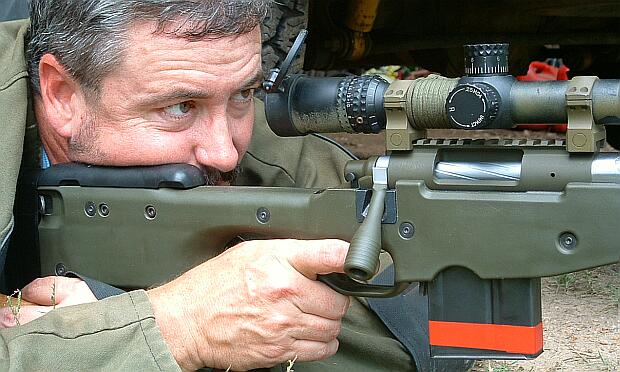
We asked Terry to omit the boonie hat and shooting glasses for this photo. He always wears ear and eye protection when shooting.
6.5mm-08 Ackley Improved--A Very Effective Long-Range Cartridge
by Terry Cross
Like most working adults these days, my practice time is very limited and when I do get to shoot, it is limited to ranges under 300 yards. Also living in a state (Louisiana) where typical winds never get above 10 mph, my wind doping experience is limited compared to our western cousins. In the tactical shooting discipline, the .308 Winchester is still the all-around favorite workhorse, but with competitive scenarios sometimes stretching out to the 900- or 1000-yard distance and at locations where the wind can average 20+ mph, I am looking for a more efficient cartridge to tackle these demands.
My current rifle is built on the superb Surgeon action with a Krieger 1:8.5" twist barrel chambered in 6.5mm/08 Ackley Improved. So far, the results are encouraging to say the least.

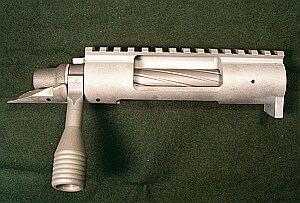 Putting Together a "Bomb-Proof" Package--Components of Choice Putting Together a "Bomb-Proof" Package--Components of Choice
My competition rifle, a no-nonsense "working gun", is built on the new chrome-moly action from Surgeon Rifles. I had been fortunate to see the Surgeon action come into being as the brainchild of some talented machinists and shooters in Prague, Oklahoma. Designed and manufactured from the ground up as the next step in serious tactical rifle evolution, the Surgeon action boasts an integral 20 MOA Picatinny scope base, integral heavy recoil lug, one-piece bolt construction (no welded or soldered handle), and a heavy-duty bolt stop mounted on the side of the receiver. Final dimensions are machined after heat-treating to insure perfect squareness and alignment. This action also boasts more thread length for the barrel shank. Typical barrel shanks for the Surgeon have a thread length of 0.950" versus the 0.700" thread length in Remington Model 700 style actions. This provides a 37% increase in barrel engagement. More engagement is always a good thing for stiffness, accuracy and ruggedness.
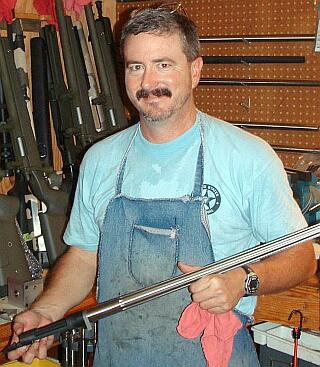 This action is built to perform and survive in the grueling environment of tactical-type field shooting as well as Law Enforcement and military sniper applications. It is built to the same precision and squareness as the best benchrest action but has fit tolerances that allow it to function under harsh conditions, and where dirt or debris might stop a benchrest action in its tracks. The Surgeon action is ready to go upon receipt. Checking the receiver and bolt in fixtures confirmed that it is turn-key with no other work needed except the metal finish of your choice (it is manufactured "in the white".) This action is built to perform and survive in the grueling environment of tactical-type field shooting as well as Law Enforcement and military sniper applications. It is built to the same precision and squareness as the best benchrest action but has fit tolerances that allow it to function under harsh conditions, and where dirt or debris might stop a benchrest action in its tracks. The Surgeon action is ready to go upon receipt. Checking the receiver and bolt in fixtures confirmed that it is turn-key with no other work needed except the metal finish of your choice (it is manufactured "in the white".)
Utilizing the proven Remington M700 striker assembly, ejector and snap in extractor, any police armorer or gun shop can service and keep a Surgeon-based rifle shooting indefinitely. The Surgeon action is also offered in a tighter-fitting, single-shot version for the F-Class and varmint hunting crowd.
Krieger Barrels has been my primary barrel blank supplier for the last 16 years. I've had nothing but superior performance from them, so I had no reason to look any further for a barrel choice. The barrel on this rifle was Krieger's stainless steel, #14 Heavy Palma contour blank with a 1:8.5" twist, 4-groove bore. Finished at 26" with a deeply counter-sunk target crown, this barrel gives me good velocity numbers without being too ungainly to handle in a hurry.
For most of the rifles I build, I'll choose a stock from McMillan Fiberglass Stocks. However this rifle was placed into the excellent Accuracy Int'l Chassis System for experimentation. This stock is very rugged, has the best detachable magazine system on the market and just happens to fit my physical build very well when shooting from odd positions or standing. I performed the usual skim bedding in a U.S.M.C. pattern on the chassis of this stock. This gives a perfect custom fit and supports the barrel breech area for about 1.75". This does not hurt the accuracy and we believe it helps with zero retention after transporting and rough housing with the rifle between shots.
NightForce rings are lapped while in position on the receiver and carry a NightForce 5.5-22 x 56mm NXS with Mil-Dot reticle. This scope has been my main optic regardless of rifle choice for the last five years. Airplane trips, bumps, and temperature variations don't affect it. It has not flinched after bunches of dial-twisting and power range ups and downs. Resolution is clear and the quarter-MOA clicks are on the money, time after time.
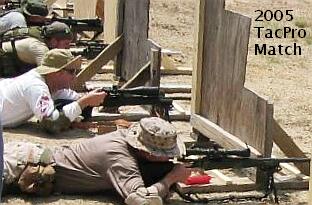 Bench? What Bench? -- This is Tactical! Bench? What Bench? -- This is Tactical!
This game requires shooters to engage targets from 35 feet to 1000 yards. With no warm up, sighters or wind flags, first-round hits are the key to success. Targets are sometimes no larger than one MOA. On longer-range events, there may be a sprinkling of 8"-10" steel circles. There are even some 12" x 18" steel LaRue targets that fall and automatically reset when hit hard enough. Most of these targets are at unknown distances and left for the shooter to laser or range with Mil-Dots. In a 22 m.p.h. cross wind, even the generous LaRue can elude first-round hits at 900 or 1000 yards.
Typical scenarios have the shooter placed in a prone position with bipod. Other positions include sitting, kneeling, standing, hanging over the rail of a tower or roof-top or evil combinations of these. Each event is designed to test the shooters ability to adapt to the situation and effectively engage the target. Although there may be a shot from a table-top, these events are not shot from a bench position. If you think the mirage can be bad from your bench top, you should take a look through that soup closer to the deck.
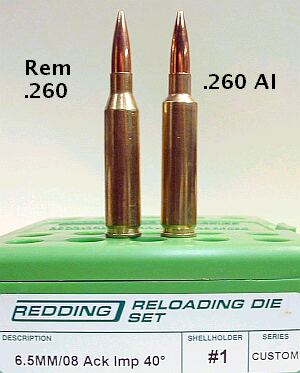 6.5mm-08 Ackley Improved 6.5mm-08 Ackley Improved
The 6.5mm-08 Ackley Improved (the model for today's .260 AI) is not a new cartridge. The basic dimensions for this round were drawn up and used by some High Power shooters in the mid 1980's. My positive experiences with customer rifles built in .260 Remington lured me down the trail to the Ackley version. The .264" bore has several excellent bullets in the 0.600 BC range but the standard .260 Remington could not safely drive them to the +2900 range in 24" to 26" barrels found on most tactical rifles. Remember that rifles in this game have to be very mobile and quickly handled at times.
I was sure I would have to draw up a custom reamer to suit my tastes on leade length, leade diameter, neck dimensions, etc. However, after working with the crew at JGS Tools, I found a stock chamber print that looked like a great candidate. This reamer has the short length, minimum-diameter leade I wanted along with several other body and neck tweaks. I wanted a chamber with no slop but that would not require turned necks. I also wanted a leade and throat that would give me a nice Cartridge OAL that would still fit in the magazine, because this tactical game is for repeaters. Since receiving the finished JGS reamer, I have had outstanding results with the 20-25 barrels I've chambered with it.
Improved Cases--Many Variations on a Theme
One thing I learned several years ago is that there are at least two variations of the Ackley improvement. There is the original Ackley dimensions and there is a Clymer variation that has slightly more body taper. My chamber copies the original Ackley pattern with minimum body taper. Also note that this case is very close to a .260 Ackley Improved but still not the exactly the same. I am pointing this out because I honestly believe any of these variations would work very well with the right leade and throat but since they all have slightly different case dimensions, it is very important to match your reloading dies to your exact version. Using the wrong body / bump die will over-work your cases or cause slop in the fit of a chambered round that will do nothing good for accuracy. Close is not good enough. Make sure your dies are for the exact round your barrel is chambered for. In our game, reliability is just as important as accuracy. There are no alibis in the event of a malfunction or mis-fire, so everything must work perfectly, every time. Because of this, we have always been a proponent of body sizing every round. When the correct die is properly set up, you can achieve perfect chambering and extraction while losing little or no practical accuracy. Note that our realistic accuracy goals are different than the benchrest crowd. We are wiling to give up one or two tenths to achieve reliable feeding and extraction even in a dirty rifle.
The main reason to go with an improved version of the .260 Rem, is velocity. For most people, the standard .260 reaches pressure limits with 140gr class bullets well before 2850 fps (with a 24"-26" barrel). The .260 AI lets you drive those same bullets comfortably at 2930 fps or better. The 139gr Scenars, 140 Bergers, and 142 SMKs all like to run in this higher speed range, and the ballistics are clearly superior. Here's a table that gives you a ballistic comparison of different cartridges. You can see the Ackley Improved .260 beats the standard .260 Rem handily:
| Cartridge | Bullet | Claimed BC | Muzzle
Velocity | Drop @ 1000 | Windage @ 1000
10mph 90° | Vel @ 1000 | | .308 Win | 175gr SMK | 0.496 | 2700 fps | 407.4" | 90.9" | 1290 fps | | .260 Rem (std) | 123gr Lapua | 0.547 | 2950 fps | 314.8" | 69.8" | 1542 fps | | .260 Rem (std) | 142gr SMK | 0.595 | 2800 fps | 338.0" | 67.5" | 1531 fps |
| .260 AI | 123gr Lapua | 0.547 | 3020 fps | 299.1" | 67.4" | 1588 fps | | .260 AI | 139gr Lapua | 0.615 | 2935 fps | 300.3" | 60.3" | 1658 fps | | 6.5-284 | 142gr SMK | 0.595 | 3000 fps | 290.6" | 60.9" | 1668 fps |
Data calculated for 500' altitude, with PointBlank software based on advertised BC. Actual performance may differ. |
Load Development, Fire-Forming, and Accuracy
If you are looking for a lengthy saga of .260 AI load development, you will be disappointed. The first H4831 loads I tried from the Hodgdon Powder web site immediately performed very well. It took just a little bit of experimenting to find a pressure and velocity range that would work in the 100-degree heat we sometimes shoot in. I meter this powder with a PACT dispenser and scale. With ES and SD numbers in the single digits (after fire-forming), I am very happy with the results.
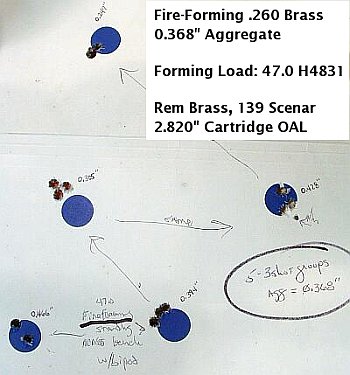 My goal of driving high-BC bullets at 2900+ fps was met with no problem. My ballistics (drop and windage) are almost identical to popular .300 WM and 6.5-284 target loads. If I can dope the wind and mirage, 24.5 MOA up from my 100-yard zero will get me a hit (hopefully) at 1K. Using the sorted Remington 260 brass, I consistently average groups in the 0.3s with fire-formed cases. This type of accuracy, long-range horsepower, and reliability is more than enough to provide excellent performance in a tactical or field rifle. My goal of driving high-BC bullets at 2900+ fps was met with no problem. My ballistics (drop and windage) are almost identical to popular .300 WM and 6.5-284 target loads. If I can dope the wind and mirage, 24.5 MOA up from my 100-yard zero will get me a hit (hopefully) at 1K. Using the sorted Remington 260 brass, I consistently average groups in the 0.3s with fire-formed cases. This type of accuracy, long-range horsepower, and reliability is more than enough to provide excellent performance in a tactical or field rifle.
Cases are primed with Federal 210M primers and charged with 47.0 grains of H4831 or H4831SC. Lapua 139 Scenars are seated to 2.820" OAL. This load produces very well-formed "Ackleyized" cases while maintaining groups of 0.500" or better. Running about 2780-2800 fps, these fire-forming loads are good enough to shoot on some courses of fire and during short-range practice.
Terry's Match Load
I full-length size fire-formed cases with a custom Redding die spec'd off my chamber. This is a non-bushing die set up to give about .003" neck tension, .0015" shoulder bump and a little sizing at the head. I full-length size every time to enhance feeding/extraction. In tactical shooting 100% reliability is the name of the game. After sizing, I load 48.5 grains of H4831 or H4831SC. That produces great accuracy, and about 2935 fps. I use the same 139gr Lapua bullet and 2.820" OAL for my match load as when fire-forming--this gives me loaded rounds that fit any short-action detachable magazine. I've found the 139s shoot a tiny bit better in my gun than the 142 SMKs, but you can use the same loads interchangeably. In some of my customers' rifles the 142 Sierras perform best, and I suggest the same loads and OAL for them as I use with the 139s. [Editor's Note: the ideal Cartridge OAL will depend on the bullet and the throat length in a particular rifle.]
One very important thing I have noticed is that even the fire-form loads give me ES below 14 and SDs mostly in the single digits. Loads with formed cases usually give me single-digit ES and SD. I don't know why, but this is a good thing. Uniformity like this is a definite plus at extended range where vertical stringing can kill your consistency. In addition to my own rifle, these loads have been used to shoot break-in and test groups in over 20 customer rifles. Every one has produced tight groups and low SD numbers. Between my experience and customer feedback, all indications are that this chamber and barrel combination is inherently accurate and well-behaved.
Procedures for Getting Best Results with Remington Brass
For my 260 AI rifles, I use the R-P brand .260 Rem as the base case. R-P is the only producer of bulk brass for the .260 Remington at this time. While I am normally not a fan of R-P cases, I was determined to find out if they were usable for my application. I have customers and friends that form .260 brass from Norma, Lapua or other top quality .243 Win cases but I did not want to add the forming and reloading steps necessary to do this. There is also a high incidence of case loss when shooting these events from grassy areas, a tower, vehicle or other busy area, so I didn't want to fret if I lost a case with hours of labor in it.
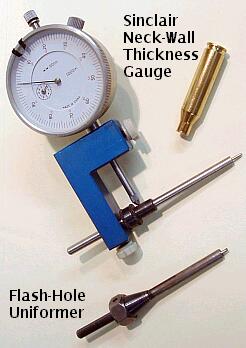 With new bulk R-P .260 Remington cases, I first size them to get the necks uniformly round. I then take a Sinclair Int'l neck thickness gauge and separate any cases that vary more than +/- 0.0015" around the neck. I also remove any that may be uniform but happen to be more thin or thick than the median for that lot. Typical lots pass 90-95% of the cases as good to go. I then debur the inside of the flash hole--thankfully a one-time task. With new bulk R-P .260 Remington cases, I first size them to get the necks uniformly round. I then take a Sinclair Int'l neck thickness gauge and separate any cases that vary more than +/- 0.0015" around the neck. I also remove any that may be uniform but happen to be more thin or thick than the median for that lot. Typical lots pass 90-95% of the cases as good to go. I then debur the inside of the flash hole--thankfully a one-time task.
I am a huge fan of Redding's three-die set with neck bushings. However, I was looking for something easier and faster for myself and my customers. Since the main case for these rifles will be R-P, the neck thickness will be fairly stable from shooter to shooter so I had Redding run a dozen two-die (non-bushing) sets with the neck dimension to my tastes. This has insured that 100% of the neck is sized, where neck bushing dies always leave a substantial amount of neck and the critical neck/shoulder junction untouched. So far, we've had excellent results--we've achieved the accuracy standards needed to win at our game. And we haven't had problems with neck tension or "doughnuts". |
Barrel Life Considerations
Since I am pushing 139gr and 142gr bullets to 2950 fps, there is no reason to believe that my barrel will enjoy appreciable gains in longevity when compared to typical 6.5-284s and .300 Win Mags. I do not have much hard data back from customer rifles yet but my money is on the 1,500 to 2000 round count before things get unpredictable. Note that any high-performance barrel setup needs to be viewed as a consumable, much the same as tires on your car. If the rest of the setup is done correctly, new barrel installations do not require die, dope or load changes from your previous setup. This can be done fairly seamlessly and quickly. If one were to view the costs involved with travel, lodging, food, range fees, ammunition and other shooting expenses, periodic barrel replacement is really a small price to pay for top performance and consistency.
Recoil and Those Unfriendly Muzzle Brakes
I install many muzzle brakes on customer rifles but personally am not a fan of them. Shooters with muzzle brakes to my right and left during training or competition is one of the few turn-offs I have experienced at these type events. Having grass, gravel and sand blown against my scope lens, into my action, and in my face is not a welcome experience for me, so I don't want to do that to other shooters. In typical 12- to15-pound tactical rifle packages, the 6.5mm/08 Ackley Improved has proven to have very manageable recoil with excellent sight recovery times on par with equivalent rifles chambered in .308 Win. Remember that some of these events require one or two shots to complete while you may have to shoot five targets in 15 seconds during another event. Rapid shot recovery and quick action cycling is a must to survive and still be in the top of the pack.
Parting Shot--Should the .260 AI Be Used by the Military?
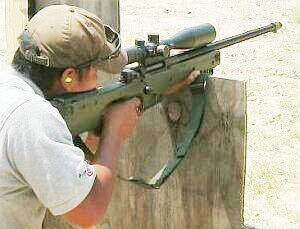 With its many virtues for tactical competition, does the 6.5mm-08 Ackley Improved show promise for widespread adoption as a police or military round? I honestly don't think so. Serious field rounds need a fair amount of body taper in the case to allow reliable feeding and extraction with weapons that are less than mechanically perfect and that may be very hot and dirty. The Ackley cases sacrifice that taper for extra capacity and in doing so become vulnerable in extreme situations. Also, new cases with 40-degree shoulder angles cannot be mass-produced easily at this time. With its many virtues for tactical competition, does the 6.5mm-08 Ackley Improved show promise for widespread adoption as a police or military round? I honestly don't think so. Serious field rounds need a fair amount of body taper in the case to allow reliable feeding and extraction with weapons that are less than mechanically perfect and that may be very hot and dirty. The Ackley cases sacrifice that taper for extra capacity and in doing so become vulnerable in extreme situations. Also, new cases with 40-degree shoulder angles cannot be mass-produced easily at this time.
While the longer .280 Ackley, 30-06 Ackley, 6mm Ackley, etc. can be made to feed from internal box magazines, the shorter .308 Win-based Ackley variations do not do so well. The existing feed rails on most repeaters can allow these cases to bind during the ramp up or release control of the round prematurely while cycling the actions. It can be made to work but care must be taken in fitting the follower and feed rails. There are tricks that can be done to help. The best situation by far is to use a detachable magazine that presents the top round to the bolt in a center feed position. The H-S Precision and Accuracy International magazines do this. Since most rifles built for this discipline can benefit from a 5- or 10-round detachable magazine feature, this is not a bad option anyway.
While the .308 Winchester and standard .260 Remington cartridges offer excellent performance in this field of shooting, I have been very encouraged by the responsiveness, versatility, ease of loading and results with the 6.5mm-08 Ackley Improved. Will it be the one for me to settle with over the long haul? We shall see. -- Terry Cross
 | Terry Cross
KMW - Long Range Solutions
129 Fish Hatchery Road
Forest Hill, LA 71430
Phone: (318) 748-8732 |  |
|
Did You Enjoy Reading this Article? If So, You Can Help Support
6mmBR.com by Making a Small, Secure Contribution.
Photos from TacPro June 2005 Match, Copyright © 2005, Zak Smith, used by permission, All Rights Reserved. All other content Copyright © 2005, 6mmBR.com, All Rights Reserved. No reproduction of any content without advanced permission in writing.
Topics: Terry Cross, KMW, Long Range Solutions, Accuracy International, McMillan, Fiberglass Stocks, .308 Win, .260, 260, .260 Ackley, 260 AI, 6mm, 6mm BR Norma, 6BR, 6.5, 6.5-08, 6.5mm-08, 6.5mm/08, 6.5 AI, 6.5-284, 6.5x284, 6.5mm, Score, Group, Agg, Aggregate, Benchrest, 6mm Improved, Tactical, Military, Surgeon Action, Surgeon Rifles, TacPro, Sniper's Hide Cup, Schneider, Krieger, BR, Bench Rest, rifle accuracy, Recoil, Hodgdon Powder, H4350, H4831, H4831SC, Lapua, Sierra, Match-King, Competition Shooting, Stocks, Leupold, barrel, reloading, powder, case forming, neck-turning, Remington Brass, R-P, Winchester, bullets, precision, Fiberglass.

|
|